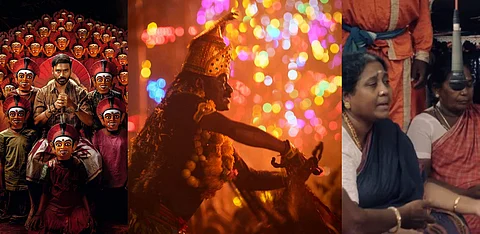

To note that Tamil Nadu is rich in culture and tradition is an understatement. With thousands of deities guarding every village and countless customs being followed in households, the region is a treasure-trove of myth. Directors Pushkar-Gayatri know this and brought to the screen the festival of mayana kollai (loot of the graveyard), in their recent hit series, Suzhal: The Vortex. We also saw director M Manikandan’s Kadaisi Vivasayi showing a real focus on rural traditions in his film, and filmmakers like Mari Selvaraj too have stepped in too with a real desire to celebrate the local.
Film historian Theodore Baskaran looks at this trend as part of a “Dalit revival”. “In the last 10-15 years, Dalit consciousness has seeped into people and filmmakers, and films based on them have started showcasing their customs. Earlier, we saw only upper caste customs and traditions being shown in films,” he says and notes that there has been an increase in stories about the working class. “Writers like Poomani, Imayam, and Jayakanthan penned stories on them, while our cinema usually has tended to romanticise rural life. It appears that we are now seeing a shift in this perspective.”
Mari Selvaraj’s last film, Karnan, came loaded with metaphors, including showing the protagonist’s dead sister as a local deity (Kaatu Pechi). “When villagers watch these elements on the screen, they can relate to them. These ring real to them and are an important part of their belief system,” he says.
Director Amshan Kumar, who has made films like Oruththi (2003) and Manusangada (2018), recalls a number of films, on rural subjects and traditions, coming out during the ‘70s. “Traditions like manjuvirattu (jallikattu), manjal neerattu vizha (puberty function), and customs like panchayat administration brought a slice of the village life to film audiences,” he notes.
Typically, local customs have been used as a backdrop for a fight sequence, or a romantic interlude. “For instance, in the climax scene of Bharathiraja’s Puthiya Vaarpugal (1979), the villain gets killed during a village festival,” Baskaran points out. “Komatha En Kulamatha (1973) spoke about the beliefs surrounding cows, while Agraharathil Kazhutai (1977) noted how donkeys were considered to be a bad omen. These films expanded on the rural belief system,” he shares.
Directors Pushkar and Gayatri took almost three years to write their recent hit series, Suzhal: The Vortex, and much of their research went into learning the many nuances of the mayana kollai festival that occupies an important place in the web series. “Many of these festivals are hearsay. The story of Angalamman changes from village to village. The crew, including the DOP and the AD, shot the festival over ten days, and did video research to understand it. Our production designer also bought a lot of props from the festival. We wanted the portrayal in our series to be as close to reality as possible,” the duo says. “Larger epics like Ramayana and Mahabharata are well-documented, but these smaller festivals and traditions aren’t.”
Baskaran, too, observes that there is very little literary work written on gramapura deivangal (village deities) like Karuppasamy and Ayyanar. “If a couple is trying to conceive, they make a sculpture of a pregnant woman out of the mud and place it in a temple. Such customs can only be seen in person or perhaps through films,” he says.
Filmmaker Madhumita, who helmed KD Engira Karuppudurai (2019), believes it is crucial to understand the significance of rituals and traditions before utilising them or speaking about them. Her 2019 film is based on the ritual of Thalaikoothal, a traditional form of euthanasia. “I had assumed that it was widely practised in villages as they might not be able to afford treatment, but I learned that even doctors and professors believed it is okay to pull the plug when a patient is seriously ill. We must understand the traditions and why they exist, before critiquing them,” she says.
Director Anand Ravichandran’s Sethum Aayiram Pon (2019) delved extensively into the idea of oppari (lament) and was shot in and around Appanur, near Paramakudi, where it is practised widely. “The contemporary form of this tradition differs from what existed in the earlier days. In order to bring out the rustic flavour, I cut off shots that looked cinematic. For me, the authenticity of the art form comes first, and only then, its interpretation.” It’s fascinating that while filmmakers like Anand Ravichandran and Madhumita make the ritual a part of the story itself, those like Mari Selvaraj and Pushkar and Gayatri also utilise them as metaphors. Apart from making those familiar with the customs feel a sense of intimacy with the story, such films and web series also serve to introduce the uninitiated to the countless rituals and traditions inherent in our region that many times contain wisdom, knowledge, and often, history too. As Madhumita says, criticise them if you must, but let’s understand them first. It appears that our filmmakers have started taking a real interest in doing that.